“Every man has his secret sorrows which the world knows not; and often times we call a man cold when he is only sad.”
~ Henry Wadsworth Longfellow
Apr 10
March 2019 – Quote of the Month
Mar 31
The Hit and Run Breakfast
The humor in today’s video, speaks, I think, for itself. (But then again: I have a robust, dark sense of humor: so your mileages may vary.)
This snippet is from Dragnet, The Hit-and-Run Driver which first aired April 6, 1967. In this snippet, Joe Friday (Jack Webb) and his partner Bill Gannon (Harry Morgan) meet a reporter over breakfast to discuss an article he is writing on traffic accidents.
Spoiler alert: Joe goes on to make the reporter rush off to puke.
Here is the are a couple excerpts (variations) that can be used for a ringtone:
Mar 31
February 2019 – Quote of the Month
“The supernatural is the natural not yet understood.”
~Elbert Hubbard
Feb 26
Did Peter Make a Peter Joke?
Continuing my observations of watching late night reruns, today I bring you a shocking Brady Bunch double entendre. In this scene, Peter storms in, thinking his brother Greg has taken the girl he wants to date. At first, he only calls Greg a, ‘rat’. After confronting Greg, Peter basically calls his brother a big putz directly to to the faces of their parents. – But he does it in a classy way, because this was the 70s and a family show, after all.
“Talk not to me of blasphemy, man; I’d strike the sun if it insulted me.”
~ Herman Melville
Feb 25
January 2019 – Quote of the Month
“How do I confront aging? With a wonder and a terror. Yeah, I’ll say that. Wonder and terror.”
~Keanu Reeves
Jan 31
Mike Brady’s AT-AT
In my efforts to ease my mind into sleep at night, I like to watch older TV shows. I find little easter eggs in them. Some quasi-historical, most TV trivial, and some musings of my imagination. And it is from the latter, that I bring you an episode (#17) of the Brady Bunch, “Coming Out Party“. The episode first aired January 29, 1971 and in it, Mike’s boss, Mr. Phillips enter’s Mike’s office and invites the Bradys to spend a day on his boat.

What caught my eye was the artwork in the wall. Computer, ‘enhance’…

Clearly, this is very early concept are for Star Wars: The Empire Strikes Back. – All Terrain Armored Transport / AT-AT walkers.

Jan 29
December 2018 – Quote of the Month
“If you want to know what a man’s like, take a good look at how he treats his inferiors, not his equals.”
~Harry Potter and the Goblet of Fire
J.K. Rowling
Dec 31
Iceland Seascape
The world doesn’t need another Iceland landscape photo. At least: not another unexceptional Iceland landscape photo. But I need a blog post and am out of time and out of sorts to do more than slap up one of the photos I took this year. Ergo: I give you: “Generic, but Lovely Seascape Captured in Pixels.” (My titles need help.)
There isn’t much of a story to it, other than to say that the photo was taken as part of our Ring Road trip this summer. The picture was taken on the shore the charming Lonkot Rural Resort in the North West of Iceland. We walked the lonely, stony, cloud crowned beaches and enjoyed a chilly, moody summer day.

Dec 22
November 2018 – Quote of the Month
“War must be, while we defend our lives against a destroyer who would devour all; but I do not love the bright sword for its sharpness, nor the arrow for its swiftness, nor the warrior for his glory. I love only that which they defend.”
~ Faramir
The Window on the West
The Two Towers
The Lord of the Rings
J.R.R. Tolkien
Nov 30
Iceland’s Steinahellir Cave Signs
Along the road, In the south of Iceland, near the Bay of Holtsós is a small cave.

The cave is not very deep: little more than an alcove. It is so shallow, in fact that it gets enough light that the entirety of the cave is overgrown with ferns and moss. The small grotto is gated, with a man-door, no doubt: to prevent people from driving their vehicles into the cave.

On the exterior of the gate are two signs.
One sign is a hand written, haphazardly cut white sign that reads, in fading ink, “NO CAMPING!’
Beside it, is a professionally illustrated, multilingual graphic sign that illustrates and reads, “NO HUMAN WASTE”.
I’ve never been one for scatalogical humor, but the dichotomy and priority of investment between these two signs, posted on a natural formation, amuses me and was the highlight of the visit to the cave.
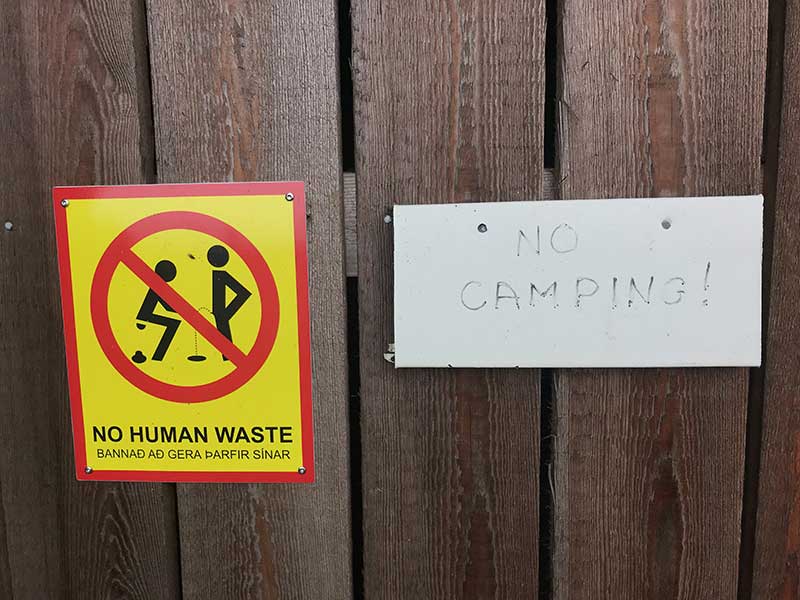
Nov 01
October 2018 – Quote of the Month
“Listen to them — the children of the night. What music they make.”
~ Bram Stoker
Dracula
Oct 30
Penny-ante
I shop a lot with Amazon. A lot. – With few exceptions, I go to Amazon for 95% of my non-perishable purchases.
But for some things, I still like to have an in-person experience. These things include: TVs and monitors (for first hand viewing of image quality), audio gear (hearing is believing), furniture and vehicles (for a sense of mass and aesthetic details that aren’t easily translated in photos), home maintenance like lumber and yard care (due to bulk) and shoes and clothes (for fit).
It is for the last of these: clothes – specifically: some jeans, that I found myself at J. C. Penney.
Now, people who care about fashion, most likely snort and turn up their nose at Penneys; but I’ve never been one to care very much about clothes nor branding. (A fact, I’m sure, is probably all too obvious for those who see me.) Penneys have always been a simple, affordable option. Unfortunately, increasingly, too many local brick and mortar shops have been failing in their value and Penneys has been on the same downward spiral.
This makes me sad, because I can appreciate the loss of local retail, even big-box retail to Amazon, but my shopping experience for jeans is surely an example of why brick and mortar stores are getting their asses kicked.
The fundamental disappointment I encountered with Penneys was the lack of service. – Caused, by the store being short staffed. There was no one in sight in the mens’ section, and I was left to find it by myself, and comb through the jeans for style and fit without an offer of help. Next: the dressing room was dingy and unkempt. The pincushion on the wall looked liked it hadn’t been cleared for who knows how long. Other pins were littered on the floor.

Finally, at checkout, the line was about four people deep, with a single clerk working to resolve a customer’s problems, leaving me to wait for about 20 minutes to get rung out. And when they did tally my sale, the sales promotion didn’t ring up correctly and I had to have it redone. (An error that I noticed: not the clerk.)
Now, I list these ‘grievances’, fully aware that they fall into the category of ‘first-world-problems.’ But that isn’t my point. My point isn’t that this isn’t any kind of real suffering but rather: to highlight why I think stores like these are failing.
With Amazon, I could have saved myself a 30 minute drive to the mall. (x 2 for return trip home.) – I could have shopped from my phone anywhere I was. With Amazon, I could have filtered and sorted my choices within seconds. With Amazon, I could have just as easily shopped for a Gummy Bear anatomy puzzle or a vinyl wall decal of an Asian businessperson. With Amazon, I could have checked-out with a click of a button.
Yes, with Amazon I would be waiting two days for them to arrive but 99.9% of the time: I can wait. So, the only real remaining shortcoming with Amazon is the hassle if I have to return a product.
But consistently, where Penneys should have shined: they failed – customer service.
I can’t help but think that some CEO made a short-term decision to cut staff at Penneys to ‘help the bottom line.’ And I well imagine that having shown some operational savings, the CEO pulled their golden parachute and drifted away on a cloud of bonus money, leaving the company that much less prepared with a competitive advantage.
Amazon, on the other hand, has sacrificed short term profitability in order to master the world of retail. This is why they will win.
Oct 01
September 2018 – Quote of the Month
“Oh, life is like that. Sometimes, at the height of our revelries, when our joy is at its zenith, when all is most right with the world, the most unthinkable disasters descend upon us.”
~ Ralphie (Narrator)
A Christmas Story by Jean Shepherd
Sep 26
Carol’s Dating Didn’t Go Well After Mike Brady Left the Family
Things were rough for Carol and the Brady family after Mike Brady left.
Sep 18
August 2018 – Quote of the Month
“I don’t want to hear the specials. If they’re so special, put ’em on the menu.”
~ Jerry Seinfeld
Aug 21
Insect Screens Will Not Stop Children from Falling Out of Windows
I love product warnings about obvious things and I wonder if they’ve ever stopped a single injury. I figure if you’re not smart enough to figure it out on your own, you’re probably not smart enough to heed a warning. – Assuming you’re able to read in the first place.
Of course, the reality is that these stickers aren’t put on products to warn stupid people. They are put on to protect companies from lawsuits from stupid people.
I spotted this warning a few years ago in an office building and just recently uncovered it as I was combing through old iPhone photos:
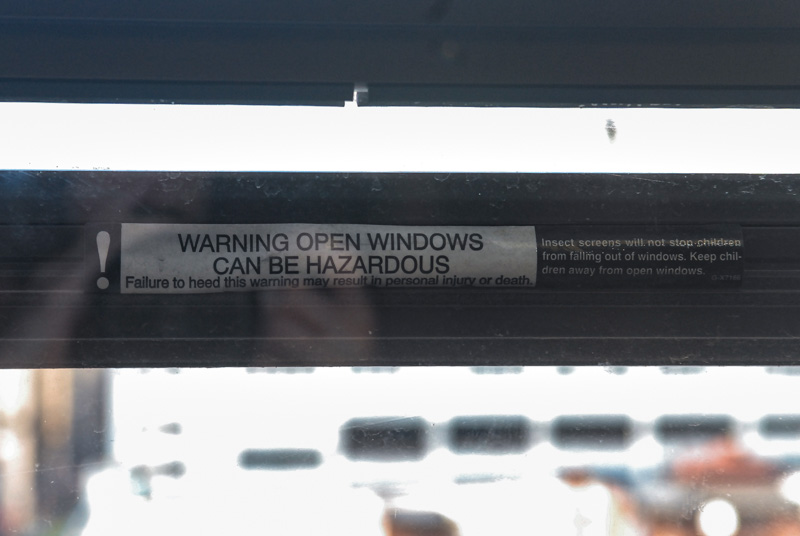
Warning open Windows can be hazardous. Failure to heed this may result in personal injury or death.
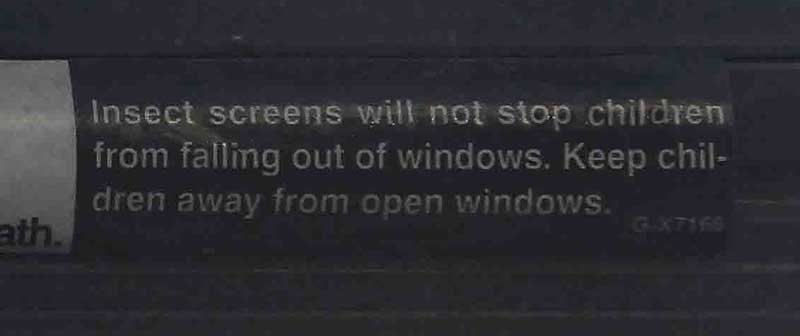
Insect screens will not stop children from falling out of windows. Keep children away from open windows.
Aug 09
July 2018 – Quote of the Month
“Many religions now come before us with ingratiating smirks and outspread hands, like an unctuous merchant in a bazaar. They offer consolation and solidarity and uplift, competing as they do in a marketplace. But we have a right to remember how barbarically they behaved when they were strong and were making an offer that people could not refuse.”
~Christopher Hitchens
Jul 30
And the Award for Most Wasteful Packaging Goes To…
The chain we use to hang our hammock has gotten tight as the trees have grown. I decided to replace them with webbing. So, along with a number of other items, I ordered two climbing slings at the same time.
I received a few boxes including one each for the webbing slings. It was actually depressing: I felt like I burned an acre of rainforest.

Jul 13
June 2018 – Quote of the Month
“Thus mystery is made a convenient cover for absurdity.”
~John Adams
Jun 30
Dismembered Drawings
I’ve been doing some significant reorganization which has required combing through lots of stuff I haven’t looked at for ages. Among some of the containers I found old drawings. Here are two that I did – probably when I was in eighth grade. I’m pretty sure that the drawings that I did then would not pass the new ‘zero-tolerance’ standards of today’s schools. but I turned out alright. Mostly.

Dismembered finger drawing.

Dismembered eyeball drawing.
May 22
17 Years of Whistling into the Wind
Happy 17th Anniversary my dear old website.
Another year and this website will be the age of consent. They grow up so fast.
“I still blog, but I do think blogging will become obsolete, as there are more ways of interacting on the Web with low barriers to entry for people to engage and participate.”
~ Biz Stone
“I think blogging, by and large, is basically therapy. And I’m sure, and I know, that there are some terrific bloggers and some legitimate bloggers. But I think, by and large, a huge percentage of people who are blogging are doing it for self-therapy.”
~Mike Barnicle
May 17
April 2018 – Quote of the Month
“The most common way people give up their power is by thinking they don’t have any.”
~Alice Walker
Apr 23
Mayberry STD
I love the little oddities that get uncovered by watching old TV shows. On the treadmill the other day, I was watching an episode of The Andy Griffith Show where Andy has an argument with Peggy and Barney tries to make things better by setting him up with another girl. Naturally, the girl is a train-wreck mismatch culminating in this line of dialog which caused me to stop my run and take a photo of the screen.

When I go out into the sun, I get the herpes.
Apr 17
March 2018 – Quote of the Month
“‘Time does not tarry ever,’ he said; ‘but change and growth is not in all things and places alike. For the Elves the world moves, and it moves both very swift and very slow. Swift, because they themselves change little, and all else fleets by: it is a grief to them. Slow, because they do not count the running years, not for themselves. Yet beneath the Sun all things must wear to an end at last.'”
~Legolas
The Great River
The Fellowship of the Ring
The Lord of the Rings
J.R.R. Tolkien
Mar 31
The Love Boat Promises Something for Everyone
I like watching old TV shows before I got to bed. Something about them helps me relax. So, I’ve been queuing up random shows in the DVR including Hogan’s Heroes, Columbo, Different Strokes among others.
The shows are wonderful time capsules: often with hidden marvels. – Sometimes the shows are remarkably clever, others are so bad that it’s stunning to imagine how many people tuned into these shows for years. This latter point brings me to The Love Boat: a show that ran for nine years – from May 5, 1977, until May 24, 1986 (with three-hour specials aired in 1986–87 and 1990).

The episode that I recorded had a trifecta title, “Miss Mom/Who’s the Champ/Gopher’s Delusion“. It was first released on February 1, 1986.
The cast was surreal. My, how some things have changed…
IMDB credits Caitlyn Jenner as the wrestler “Lover Boy Bob” (as Bruce Jenner).

In the story arc, “Who’s the Champ”, Lover Boy Bob is wooing another wrestler’s sister. And both wrestlers Lover Boy and the ‘The Mangler’ Sharkey (played by Tim Rossovich) are smacked around by none other than Hulk Hogan before the sister, Linda Sharkey (played by Jennifer Holmes) settles the dispute by locking them into a steam room together.
And of course, the show wouldn’t be complete without the patron saint of shark jumping: Ted McGinley.
“Love, exciting and new
Come Aboard. We’re expecting you.
And Love, life’s sweetest reward.
Let it flow, it floats back to you.Love Boat soon will be making another run
The Love Boat promises something for everyone
Set a course for adventure,
Your mind on a new romance.And Love won’t hurt anymore
It’s an open smile on a friendly shore.
Yes LOOOOOOOOOOOOOOOVE!Welcome Aboard. It’s LOOOOOOOOOOOOOOOVE!”
Mar 08
February 2018 – Quote of the Month
“The suspense is terrible. I hope it will last.”
~Oscar Wilde
Feb 28
Nobody Puts Baby in a Box
Doing some more organizing around the house which means more bins and labels!

I have to say, this warning label has saved me from a lot of embarrassing situations…
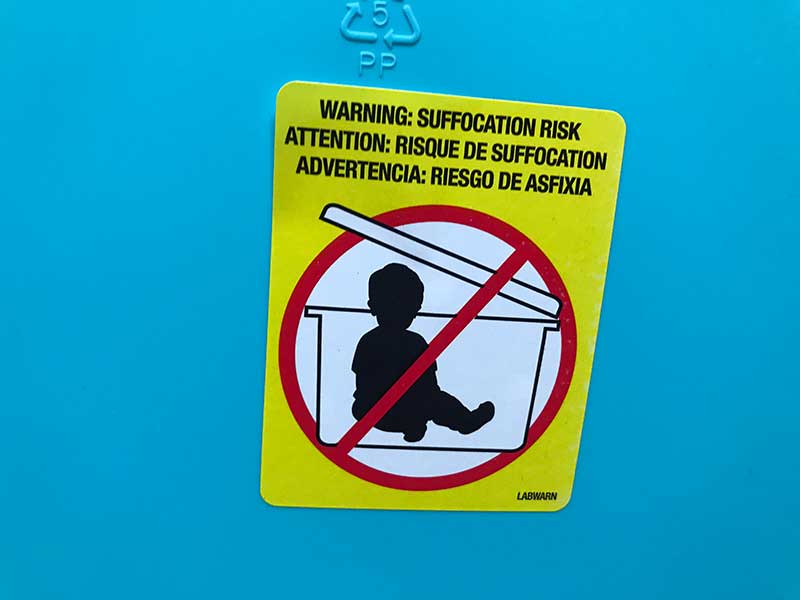 Seriously though: every hospital should have to show this label to every parent of a newborn before allowing the parents to take the baby home. The parents should be asked if they find the label useful. If the answer is, ‘yes’, then they should not be allowed to take the kid home. *
Seriously though: every hospital should have to show this label to every parent of a newborn before allowing the parents to take the baby home. The parents should be asked if they find the label useful. If the answer is, ‘yes’, then they should not be allowed to take the kid home. *
* Editorial Note: Yes, I’m being glib about a warning that almost certainly has arisen from some very sad circumstances. – I’m just not sure that such a label is ever going to make a difference in such cases.
~ Editorial Note 2: I think I may have written about this before but it never ceases to strike me as surreal. Apologies for any redundancies.
Feb 08
January 2018 – Quote of the Month
“There is no charm equal to tenderness of heart.”
~Jane Austen
Jan 24
Containers, Label Makers and Severed Heads
Three of my favorite things: organized Sterilite and Hefty containers, my Model PT-D40 Brother Label Maker and Halloween severed heads. 
Jan 09
December 2017 – Quote of the Month
“National boundaries are not evident when we view the Earth from space. Fanatical ethnic or religious or national chauvinisms are a little difficult to maintain when we see our planet as a fragile blue crescent fading to become an inconspicuous point of light against the bastion and citadel of the stars.”
~ Carl Sagan, Cosmos
Dec 30
A Rainbow of Stone
I wanted to write a post expressing my frustration and outrage at the train wreck of modern conservative politics, but I just finished a long post on my password protected Friends and Family section and I’m out of steam. These things need said: flares of distress need sent up. Spotlights of attention must be shone. Drums pounded. Voices raised.
But we must also breath… And so, here at the end of the year, I share with you a moment of Zen and I hope that the New Year sees a turn of the tide.
This is a photo I took of Rainbow Bridge this September. – A rainbow of stone that is surely weathered but that stands in the sunlight in spite of the time. Perhaps a metaphor for our hearts.
Dec 03
November 2017 – Quote of the Month
“Every man is guilty of all the good he did not do.”
~ Voltaire
Nov 26
Staring at the Sun
Congratulations to the Staring at the Sun team that wrote, directed, acted, produced and worked on the movie for winning Best Feature Film at the Big Apple Film Festival.
As IMDB says about this humanist movie, “Two teenage Brooklyn Hasidic schoolgirls, unable to live under the strict rules of their community take the family car and run away across America to find what they assume will be the life of total freedom that lies beyond their insular world. They discover that a world where they don’t understand the game is more dangerous than a world with too many rules, and they try to make their way in a new context, under new identities, and within an entirely new lifestyle.”

BAFF’s 2017 Best Feature Film Winner, November 07, 2017 at the Tribeca Cinemas with winner Writer / Director Harry Greenberger accepting the award.
I’m looking forward to the next movie by from the same directing, writing, producer team.
Nov 13
October 2017 – Quote of the Month
“Nationalism is an infantile disease. It is the measles of mankind.”
~ Albert Einstein
Oct 19
The Guts to Corpse a Skeleton
Corpsing a Skeleton
“Corpsing” is the Haunters’ verb for taking a skeleton and turning it into a corpse – something with a little skin on the bones. (And while we’re handing out definitions, “Haunters” is the name given to those of us who have a fixation with Halloween – specifically with the creation of haunted houses, fiendish home decorations and costumes.)
Even though I’m not having a Halloween party this year, I’m already planning for one next year. So, with many stores displaying their Halloween goods, I’m compulsively buying decorations. This means, for example, that every time I find myself at Home Depot these last couple of months, I’ve purchased a skeleton or two. (Home Depot and Walmart have the best prices. Sadly: Spirit Halloween is almost twice the price of those stores.)

Two Home Depot skeletons in cart, on route for a very dark fate.
Once I got my latest skeleton home, I laid it our on a work table and surrounded it with paints, sprays, stains, plastic sheeting, plasters and all manner of chemicals.
My goal for this project was to experiment with different methods to create a ‘juicy’ corpse with many organs still in tact.

The operating table and supplies.
I wanted to create a simple set of organs: faux lungs, tracheal tube, intestines, liver and heart.

Plaster craft cloth, bucket and two air packing bags that were transformed into the Skeleton’s lungs.
I used plaster cloth bandages that I purchased from Amazon to wrap some packing bubble bags as a form for the lungs. For other organs, I used roughly formed tin-foil bases. I kept the organs simple and undetailed because much of their presence is buried under layers of plastic ‘skin’.

Plaster wrapped packing airbags for lungs and a tin foil air pipe ready for plaster wrapping.
I’d thought to use some ping pong balls for eyes, but the ones I bought were too big for this particular skeleton. Besides, this model had glowing red L.E.D. lights and the addition of eyeballs may not have obscured those lights too much.

Lungs, air pi[es and heart, ready for paint.

Testing placement of organs into the chest cavity.
In order to give the corpse some more form, I also experimented by adding some plaster cast to the hands. In the end, that probably wasn’t required and could have been just as well executed with built up, melted plastic wrap.
The plaster cloth is great for creating sturdy structures, but the results look very much like pock-filled cloth. I mitigated this with heavy does of glue, plastic, paint and glossy paints to give a more organic material feel.

Adding a plaster base for creating a more fleshy hand.
I painted the organs with a combination of fluorescent and standard paint. Throughout the project, I tried to walk a line between realistic colors and fluorescent that would at least partially glow in black-light.

The first layers of paint on the internal organs.
Before I started to layer in the organs and skin, I gave select portions of the skeleton’s torso a red and black spray-paint job to emphasize its depth.
I covered the eye’s LED lights with electrical tape before spray painting the sockets, thinking that I’d later remove the tape. In the end, I kept the tape in place after a test revealed that the red light behind them gave an eerier glow.

Red paint on the inner skeleton.
Once I had a base level of bloody color on the skeleton itself, I laid down cut painters plastic tarp within the chest of the skeleton. I pulled portions of this up through the neck hole so that it would appear as remnants of tendons, sinew and veins once melted.

Lining the skeleton with Home Depot painter’s drop cloth (.7mm).
Organs were laid in next before they were in turned covered around with plastic.

The organs being placed onto the plastic within the torso cavity.
Once all of the organs were wrapped, I melted them selectively with a heat gun.
– Note: This task (and others) were done outside in an attempt to offset inhalation of noxious vapors.

Organs sealed into the plastic wrap, ready for the heat gun.
The whole project involved may layers of plastic and paint, as I felt my way to a look that satisfied me. But quickly, with even minimal layers, the organs were quickly buried under paint and melted plastic.

Layers of grisly paint being added to the offal.
The paints looked best when they were fresh and wet. I used reds, blues, purples and pinks. The reds and purples looked best, but I was glad to have hints of other colors.

Drying over night.
On my initial pass, the intestines appeared insufficiently connected to the rest of the body, so I added more layers of plastic across the torso, trying to get a cohesive look.
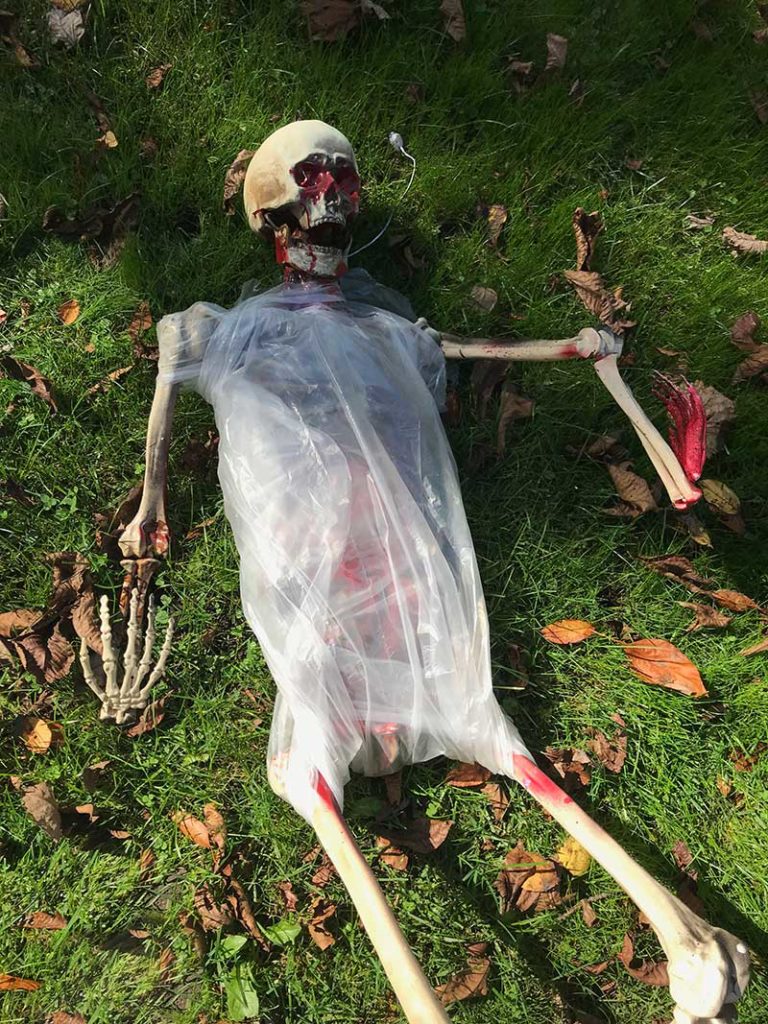
Adding more layers of plastic skin, prepped for the heat gun.
I love the organic holes that form when the plastic melts: creating the look of body fibers disintegrating.

Melted plastic skin, sans paint.
It’s hard for me to muck-up the skull. I love their ‘unskinned’ look. Nonetheless, in order to obtain the look of a fresher corpse, I added plastic wrap which I melted with the heat gun.

Skull wrapped in plastic.
I added a lot of melted glue to simulate layers of sinew and veins. (Again: bulk glue sticks bought from Amazon). On top of all of this, I used stain from Home Depot to paint the melted plastic ‘flesh’.
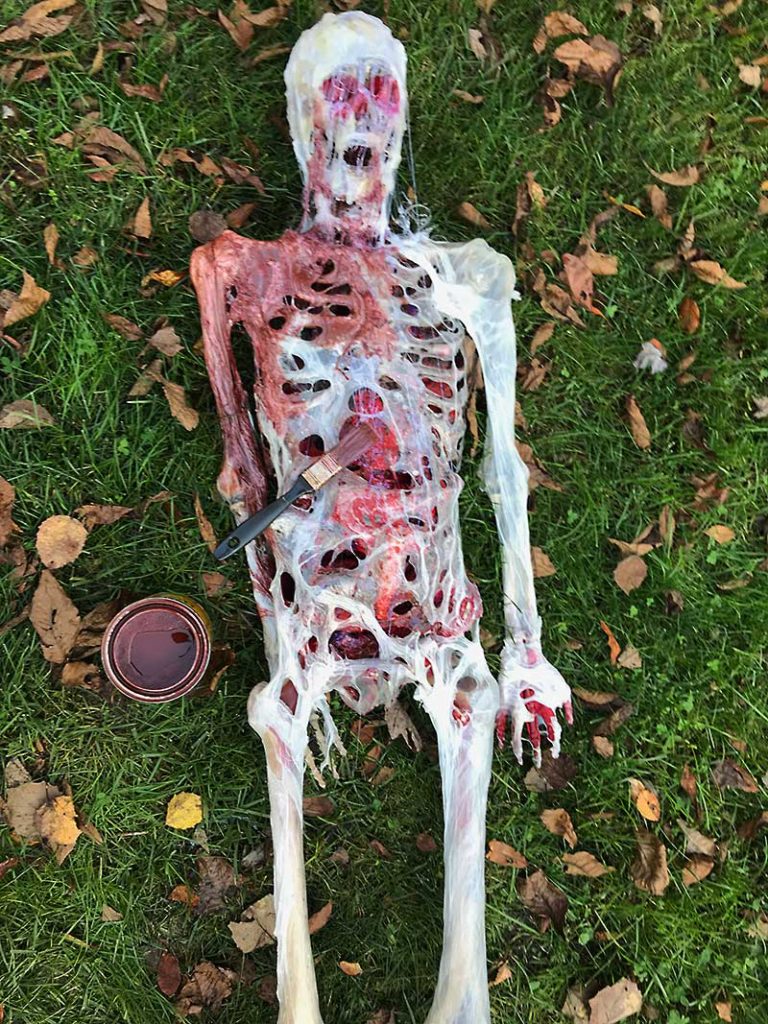
Staining the newly melted plastic skin.
I was actually happy with this version of the corpse, but it was too similar to another one I’ve done, and I felt that much of the blue, purple veins and organ details were lost.

Stained corpse. I actually liked the skeleton a lot at this stage and could have stopped, but I wanted something more ‘meaty’ and asymmetrical: as if parts of the body weren’t as decomposed.
I also found this version too symmetrical, and at the prompting of friends, I added more layers of plastic muscles to the left arm to imply a corpse that was decomposing asymmetrically.

Building up the left arm, with additional plastic wrap to help create a less symmetrical corpse.
All of the glue and plastic had buried the teeth, making the skull look too much like a blob, so I took a Dremel to the teeth and did some creative dentistry.

The teeth had been covered by too much pseudo-gore, so I took a Dremel to expose the teeth and make them appear more generally abused.
I revisited the skull throughout the project, and added some more character with subsequent layers of paint and plastic. The glowing L.E.D. eyes had a surprisingly good effect as they glowed behind the layers of glue and paint. (Not shown illuminated here.)

Post dental cleaning skull closeup.
I dribbled layers of blue and red veins and arteries across the body. I’d tried painting them on with a brush, but the texture was too rough and failed to provide the organic look that I could achieve with the less work intensive effort of pouring paint right onto the body.
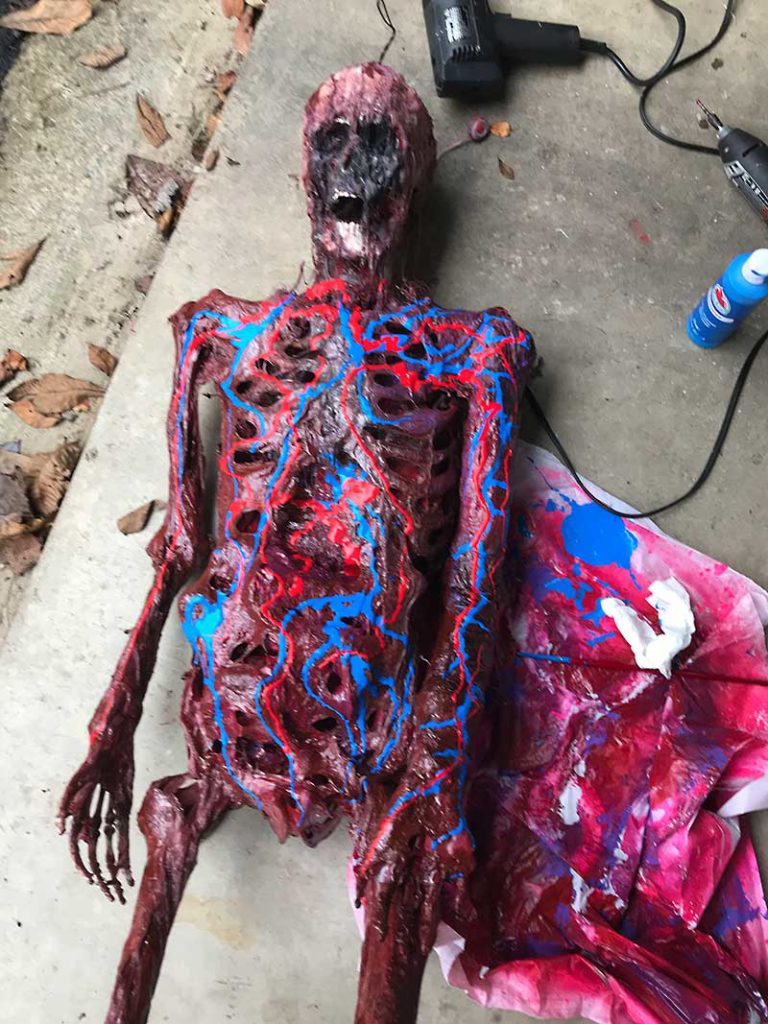
Painting in arteries and veins.
The paint looked too bright and 2-D for my tastes and the body was still looking too symmetrical so I added another layer of 3-D sinews but this time rolling the plastic into long tubes before hitting them with the heat gun.

Adding 3-D veins and sinew.
I was also not satisfied with the default flat hand pose, so I bent back select fingers and blasted them with heat and held them in place with tape while they re-hardened, giving them more of a sinister pointing look. For my next corpse, I’ll do this process before the body is covered in goo.

I don’t like the standard, flat hand pose of the skeleton, so I took a heat gun to the fingers, bent them back and held them with tape so that they’d freeze into more of a sinister pointing gesture.
Still, I found the body too symmetrical and too much of the organ details were getting lost, so I ripped back the plastic skin on the right side of the torso and even went so far as to cutting a couple of ribs, bending them outwards under heat, simulating some unfortunate trauma.

I broke a few ribs and tore back layers of plastic skin on the body’s right side since much of the organ details had been lost, buried under layers of flesh.
The final corpse had the majority of the rot on the body’s right side.
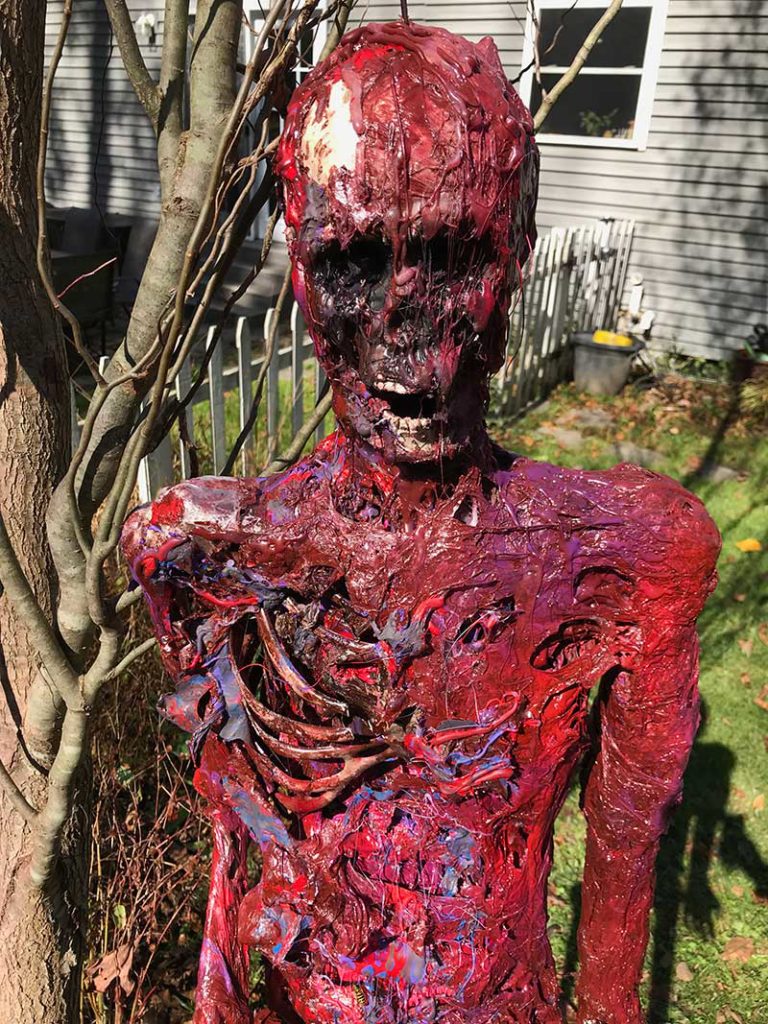
Torso of the nearly finished product. (The only addition was to hit the organs with high-gloss clear enamel to maintain a wet look.)
I finished it up with high gloss clear enamel, concentrating on the goriest bits for that fresh, moist look. I think that, when actually staged for Halloween, a good touch would be the inclusion of crows, rats or bugs.

The whole figure, hung to dry from a tree.
For my next body, I may try a dusty, ancient partially mummified corpse for one body or perhaps a burned body. Alternately, I may build up more of the face and body with plaster cloth before corpsing the body.
The funny thing is, there is an aspect of this that isn’t easy for me. Ever since I was a kid, I kept my toys fairly pristine. – For example, I was never one to put stickers on something I owned. Even now, I like the look of the untarnished original skeletons. But clearly, I’ve not left this compulsion hold me back.
As I gleefully work on these projects, I’m left to wonder why I get some fiendish enjoyment from creating Halloween spooks. But truly, one of my ideas for fun in distressing and gorifying the pile of prop bones and skeletons that I have piled in my house in the hopes that I can scare the bejeezus out of someone.
Oct 12
September 2017 – Quote of the Month
“This is the sense of the desert hills, that there is room enough and time enough.”
~ Mary Hunter Austin
Sep 28
Seasonal Candy
Halloween candy spotted in a store.
“So what? – it’s September 28th! ‘Tis the season!“, you say.
The photo was taken on July 31st. (I kid you not.)
On second thought, maybe it was just very late candy from last year…
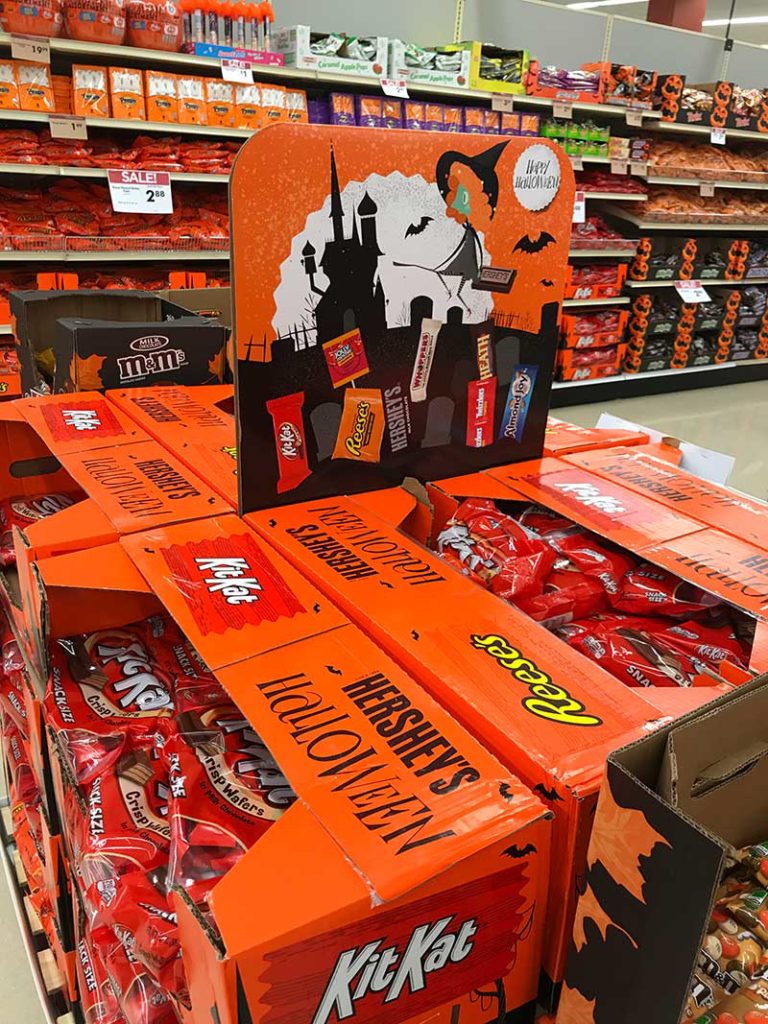
Sep 13
August 2017 – Quote of the Month
“I think some of the funniest and most artistic people I know are the ones who had a hard time at school. They often have humility and artistry. So, as much as I feel bad for kids who have to go through a rough childhood, I believe that if they can turn it around, it’s going to make them better people later on.”
~ Drew Barrymore
Aug 18
Monumental Mistakes
Since Dear Leader Trump’s recent comments regarding the Charlottesville demonstrations and related violence, I’ve seen many people on my social media channels offering a defense of the Confederate monuments. (Supplemented with bogus stories about the Confederate flag.)
First, an overview of where I stand on some related matters:
- I’m heartfelt advocate of freedom of speech, and that means unpopular speech, even speech that qualifies as ‘hate’ speech. Now, there are nuances to be explored here, such as: speech that incites violence and concerns about censorship from public media companies such as Google and Facebook that would be worth a post by themselves. It isn’t popular speech that needs protecting, it’s unpopular speech that needs the protection. But in short: I support the right of the KKK and similar hate filled groups to peacefully protest, write and speak and the best way to eliminate this speech is by the propagation of better ideas.
- I’m against the mob actions where confederate statues are pulled down and destroyed, in ignorance or willful disregard of the civilized processes of a democracy You may be right, that a statue is offense, or you may be the taliban. – Be cautious in forcing your ideas onto others: you might be right today but you might be wrong tomorrow and then your mistakes are doubled.
Remastered Ghosts of the Past
Those points made, these monuments that celebrate the Confederacy and those who lead the rebellion need to be removed or at least recontextualized from their places of commemoration.
History cannot be erased, only our memory of it and it’s very fair to be concerned when we look to modify or update markers of the past. But similarly, we must evaluate if those markers are accurate, or just. Such is the case with the heroic depictions of Confederacy.
There were certainly brave people within the Confederacy. And there were no doubt many who fought from a sense of family and a type of tribalism. But the enterprise of the Confederacy as a whole was evil: it existed with the goal of continuing some 245 years of slavery in North America and any attempt at beatification of this monstrous, generational crime is the real attempt to whitewash history.
Jefferson Slaves
At Trump’s press conference he rhetorically asked: “This week it’s Robert E. Lee. I noticed that Stonewall Jackson is coming down. I wonder, is George Washington next week and is it Thomas Jefferson the week after? You really do have to ask yourself: ‘Where does it stop?‘”
Jefferson (one of my favorite founders, I’ll note) was a slave owner. So, how do I square that with memorial’s to Jefferson? (Or Washington, etc.)
The difference being: there aren’t memorial’s celebrating Jefferson as a slave owner. In fact, if you visit Monticello you’ll find lessons acknowledging this fact and this miscarriage of his ideals.
Jefferson failed on the question of slavery when peers of his time did not, (including one of my other favorites, Thomas Paine).
But we don’t celebrate Jefferson for owning slaves. We celebrate Jefferson for the formulation of ideas that were better than the individual. – We don’t rebuke history, we look at it with a steady eye and honest heart: the good and the bad, so that we can learn from both.
History Lesson
At the end of World War II, the Germans took down the memorials of the 3rd Reich, placing them in museums and providing education around others.
We can learn from this. – Take the most noteworthy pieces, and place them in museums or grounds that provide context. Explain the history of the Confederacy, their leaders and the root cause: Slavery. (Those that aren’t of note can be stored for future consideration.)
The German’s don’t have Hitler Highschool, and neither should we.
Still disagree? What about this Kentucky memorial to Confederate General John Hunt Morgan. – It’s a nice looking piece of sculpture: cutting a nobel figure, complete with a plaque giving the visitor a synopsis of his history. What else would want to know? Why be such sensitive snowflakes about this harmless statue?
 How about the fact that the statue stands on one of the largest slave markets in the South? – How many people were torn from their homes, their loved ones, shackled and held as lifelong forced labor prisoners who’d committed no crime on this very ground? And what do we see? – A handsome depiction of a nobel Confederate General on his mighty steed – an enforcer for slave masters. Imagine if your grandparents, and their parents and their parents had been slaves and you had to walk past a statue celebrating their captors on the very grounds where they’re lives had been sold. Many of our fellow American’s don’t have to imagine.
How about the fact that the statue stands on one of the largest slave markets in the South? – How many people were torn from their homes, their loved ones, shackled and held as lifelong forced labor prisoners who’d committed no crime on this very ground? And what do we see? – A handsome depiction of a nobel Confederate General on his mighty steed – an enforcer for slave masters. Imagine if your grandparents, and their parents and their parents had been slaves and you had to walk past a statue celebrating their captors on the very grounds where they’re lives had been sold. Many of our fellow American’s don’t have to imagine.
Don’t kid yourselves, these statues tell lies but it’s not too late to set the record straight.
Aug 09
July 2017 – Quote of the Month
“The crucial test of ethical values is whether they apply to strangers, and those afar, not just in our midst.”
~ Bernard Crick, Essays on Citizenship, 2000
Jul 27
iPod Sunset
In 2014 Apple announced that it would stop supporting its professional photo management software ‘Aperture‘. Since then, I’ve been in the slow (and painful) process of migrating my photos to Adobe’s Lightroom. As such, today, I finally got around to importing a batch of old photos from October 2005 and came across this picture.
In 2005, I’d taken this photo of my, then new iPod (3rd Gen, I believe) and all of the CDs I’d ripped to it. It was a marvel.
Completing the circle of obsolescence, today, Apple announced the discontinuation of the iPod. And like the loss of Aperture, I find this regrettable since I’m partial to creating highly tailored, custom playlists as opposed to streaming mixes formulated by some unknown DJ or cold calculation.
Dear iPod, your click-wheel may be lost, but it’s not forgotten. Play on!

iPod and imported CDs, circa October 2008
Jul 27
Lettuce Spellcheck
I’ve never been a great speller, but c’mon! – Eat ‘n Park missed the pun, “Salad Bar, Can’t be Beet! Let-Us Eat”!

Jul 17
June 2017 – Quote of the Month
“Broken by it, I, too, may be; bow to it I never will. The probability that we may fall in the struggle ought not to deter us from the support of a cause we believe to be just; it shall not deter me.”
~ Abraham Lincoln
Jun 21
May 2017 – Quote of the Month
“The very concept of objective truth is fading out of the world. Lies will pass into history.”
~ George Orwell
May 30
Fluffy Pillow or ET Arms
Shopping at a local Sears Outlet, my eye was caught by a comfy looking pillow.

Looking closer, I see that the manufacturer was kind enough to provide an illustrated guide on how to use the pillow.

Looking closer yet, I noticed the girl with the E.T. Arms.
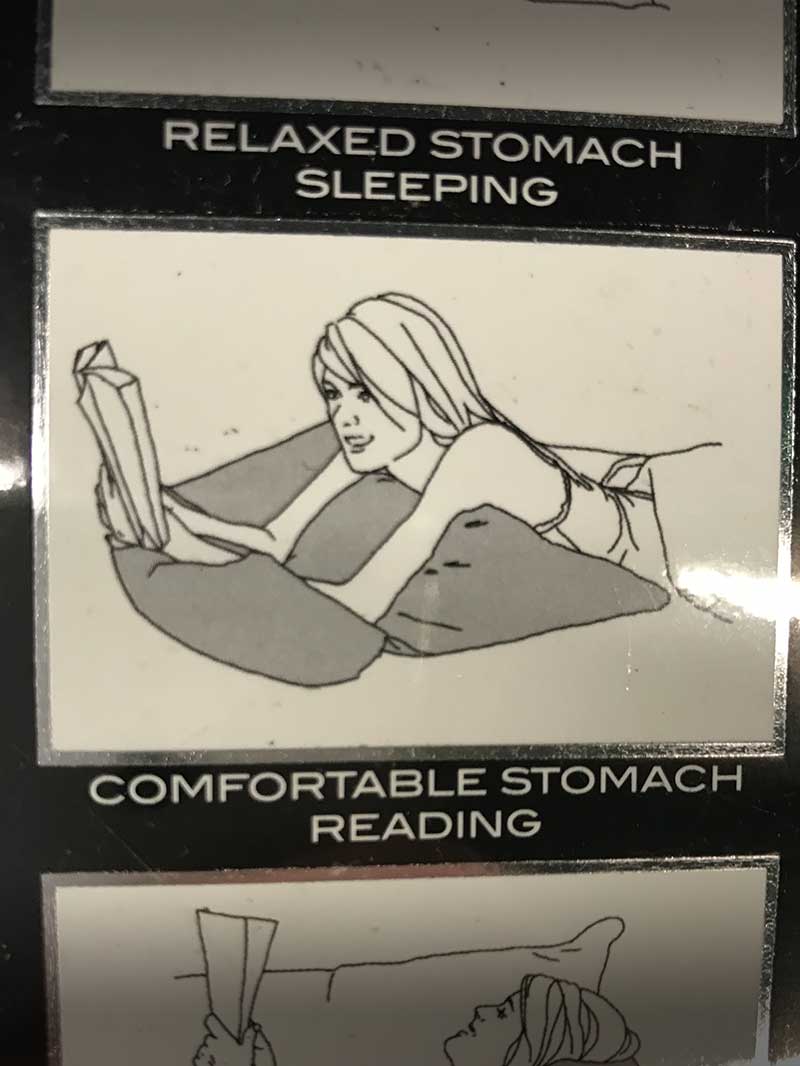
Ouuuuch…

(PS. * Yes: I know, the pillow is supposed to be just that fluffy…Still, it’s disturbing.)
May 01
April 2017 – Quote of the Month
“Belief can be manipulated. Only knowledge is dangerous.”
~ Frank Herbert
Apr 07
Who Needs a Donation When You Can Like, Share and Pray?

I spotted this on a Facebook “wall” and found it nauseating. It made me angry. The post is exploitative and cynical on such a scale that it’s hard to believe that it wasn’t purposefully, carefully, engineered to be as misanthropic as possible.
I did a little searching to see if I could uncover the story behind this particular image. – So many posts like this are old and / or have aren’t even remotely accurate (in terms of what is actually depicted or their source).
I didn’t happen across the backstory (it appears to be a new meme). But I did come across this excellent article.
The essay makes several points:
When it comes to posts like this, one share does NOT equal one prayer. One like does NOT mean you think the baby with a physical disability or difference is “still cute.” One comment does NOT mean the sick child or abused puppy “will be saved.”
Here’s what you’re actually doing when you type Amen or share the photo on your wall:
- You’re exploiting what is most likely a stolen image of a child whose family has no idea it is being used.
- You’re making the owners of the page that posted it or the twisted people who stole the photo and created the post a whole lot of money.
Don’t get me wrong: I think there is value in sharing articles and raising awareness on issues. But the vast majority of these memes are bogus (and/or painfully out of date.) Even if this case of Bella with brain cancer is real, sharing it isn’t akin to raising awareness of a cause that gets little attention. “News flash: Cancer = Bad”.
And in what alternate world is a child with a brain tumor not receiving prayers? (The efficacy of prayer aside.) “Sorry kid. You know how it is. A brain tumor is a sign that god has marked you for damnation. I just can’t be seen praying for you. It wouldn’t go over well with the big guy.” Come on people! Do you really think a kid with cancer had to mock-up a graphic for facebook to get somebody to pray for them?! YOU ARE BEING PLAYED FOR FREE ADVERTISEMENT!
I’m confident that those who click, “Like” or share are people of goodwill, but besides the dubious source and quality of these memes, there is something of a cynical escape clause in every click.
It’s easy to hit the little thumb icon and feel good about oneself, but if you want to help a cause, REALLY help – consider a donation of your time and your money. – Don’t “Like” don’t share – you’re just chumming the waters for the cynical sharks of fake news and lining the pockets of the unscrupulous.
Care to help somebody suffering from cancer? Want to share something? Start here.
Apr 07
March 2017 – Quote of the Month
“Besides, as the vilest Writer has his Readers, so the greatest Liar has his Believers; and it often happens, that if a Lie be believ’d only for an Hour, it has done its Work, and there is no farther occasion for it. Falsehood flies, and the Truth comes limping after it; so that when Men come to be undeceiv’d, it is too late; the Jest is over, and the Tale has had its Effect…”
~ Jonathan Swift

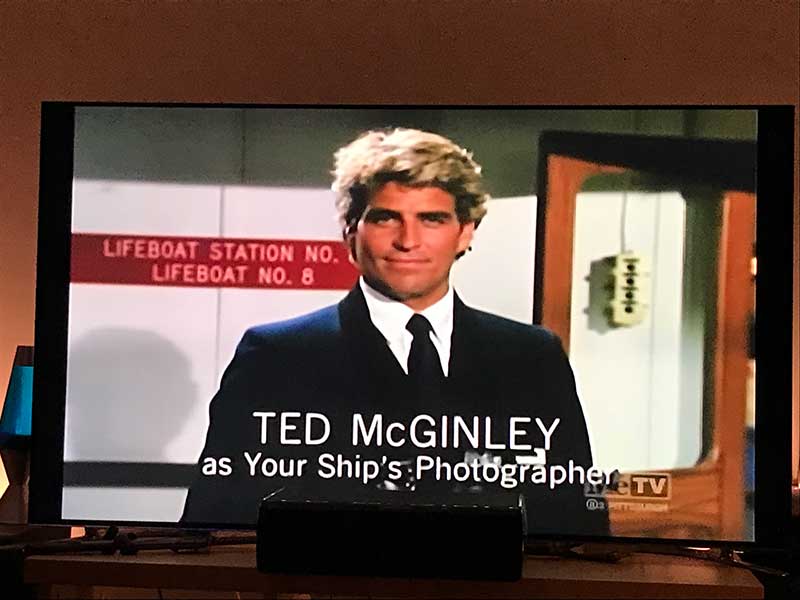

Recent Comments